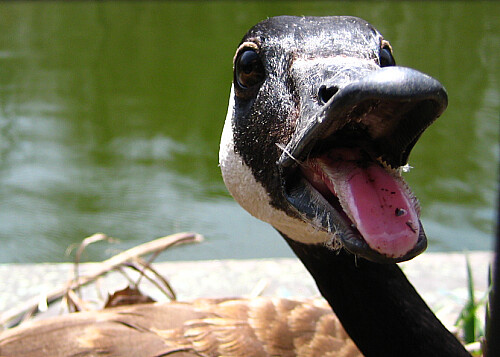Ahhhhh, springtime! Springtime was.....4 months ago. Summer has ended (at least in our hearts) and the birds have flown by unnoticed. Fall is in the air, however, and we've just come off of a couple of great days of birdwatching. We didn't bring the camera on our latest excursions to Prospect Park and Greenwood Cemetery, but we saw some first timers and familiar (but no less stunning) species, and I figured it's about time we post these pictures from our camping trip in May.
Baltimore Oriole
We woke up at about 6am and were greeted by two flame colored Orioles in a beautiful tree covered with white flowers -- the picture of springtime.

Ovenbird
The Ovenbird is a type of warbler that spends summers in the northeast. This guy looked almost identical to the painted rendering in Sibley's book, so it was an easy ID.
Ovenbird
While not evidenced in these photos, the ovenbird usually walks around with its tail up and its head bobbing. You can kind of see the distinctive golden strip across its head. Nice crest dude!
Common Yellowthroat
Albeit common, this was my first sighting of the familiar warbler. Not a timid bird, he was perched right off of the path in a grassy, marshy area fly catching in the early morning.
Yellow Warbler
Our old favorite, the yellow warbler never fails to delight.
Red-winged Blackbird
We sat on our favorite little peninsula at sunset and snapped this picture of a red-winged blackbird.
Eastern Kingbird?
Calling all birders! Can you help me identify this? I'm not convinced it's an Eastern Kingbird. I was thinking maybe an Eastern Wood PeeWee, but the breast is too white, no? Help! This was so long ago I can't give any other tips on identifying it.
Yellow-rumped Warbler
Hello old friend.
(Why you ain't nuthin but a...) Yellow-bellied Sapsucker
What an awesome name. I can't help but say it with a country western accent. Notice the red throat and the very faint yellow hue on its breast, both unique traits.
Deer
It pays to get up early! A herd of deer came right up to our campsite at around 7:30am. This guy has a really goofy look on his face.
American Goldfinch
Another common bird to most people but a first time spotted for me. You show me somebody who doesn't love a yellow bird, and I'll show you a liar. This Goldfinch graces the cover of Sibley's Guide to Eastern North American Birds, so I was especially thrilled to finally spot it.
On our last day camping, I was sitting on the throne made of rocks, enjoying a cup of coffee and warming my feet by the fire. I noticed a very, very large bird come careening down from the heavens, banking north and zipping past the trees that bordered the lake. At first I thought it must be a Canadian Goose, because I've never seen a hawk with such a wing span. I mention it to D and he's barreling through the Alders towards the waterfront trying to investigate. Good thing he did!
THE BALD EAGLE!!!!
I'd never seen a bald eagle before, but, like most Americans, am completely familiar with its bright yellow, dagger like beak and its stark white head with that Flinstone-like hemline. It even had the yellow claws. It was totally exhilarating to see something so familiar, not on a dollar bill or in The Rescuers Down Under, but IN REAL LIFE. He perched proudly on this tree overlooking the lake; the star spangled banner played faintly in the distance.
Bald Eagle
Full 180 head turn! Now that's something! Bald Eagles can have up to a 6.5' wingspan. When you see that in person it's utterly dazzling. He stayed perched on this tree for the next hour or so...we were waiting anxiously for him to take a dive in the lake for a fishy snack, but no luck.
We're gearing up for Fall Migration and are heading back to Alder in a few short weeks. Spotted last weekend at Prospect Park and Greenwood were:
Baltimore Oriole
Black-throated Green Warbler
Northern Flickers
Belted Kingfisher (lots of these at Greenwood, apparently having some territorial or mating disputes)
Northern Parula
Female American Redstart (totally fearless she was!)
Black Throated Blue Warbler
Black and White Warblers
Red Breasted Nuthatch
Blue Winged Teals hanging around with one lonely Cormorant.
Happy birding.


















































